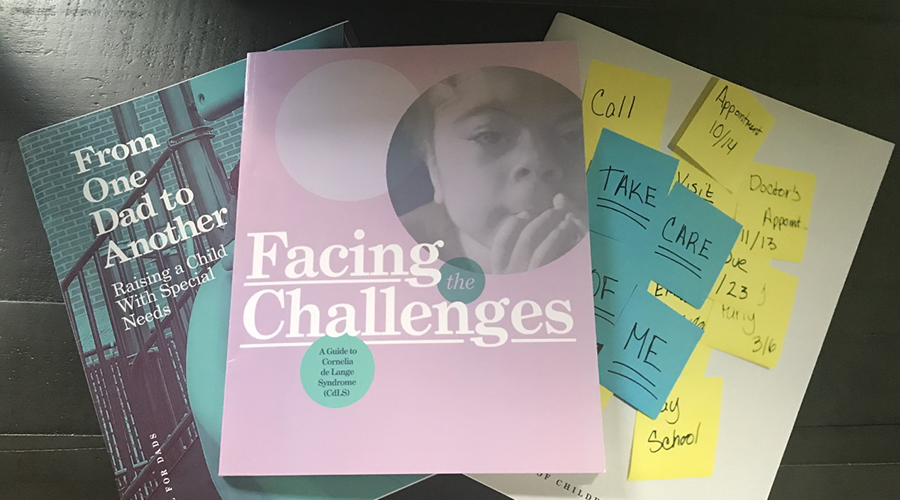Transition
Adolescence and adulthood are times of what we call “transitioning”. Your loved one is certainly changing but this is also a time of change for you as a parent.
Your role transitions from being your young child’s provider/manager to one of supervisor/counselor to your adult son or daughter. The CdLS Foundation provides you with information and support in the six key areas for a fulfilled life.
For more information regarding transition or to speak to a Family Service Coordinator, please contact the CdLS Foundation at 1.800.753.2357.

The Six Core Areas of Transition
Education: Mapping out Your Child’s Educational Plan
Please note that every student in a public education program has the right to a transition plan made at the Individual Education Program (IEP) meeting when they turn 16 years old. The Federal Individuals with Disabilities Education Act (IDEA) mandates that the plan be attached to the IEP and updated at each meeting until the student graduates. If your child is able, he or she may be present at each IEP meeting to make choices about future plans.
Once your child is in high school, it’s important to be aware that there is a specific timetable of important milestones to be accomplished at specific ages. Here are just a few of them, at age 14 or entering high school, create a Transition Plan as part of the IEP process and review this every year with your child’s school; look at graduation options since graduation can vary by state—anywhere from 18-22 years of age; identify and explore areas of interest to your child that can help guide what life after high school can be; and research other options open to you by contacting Adult Services Programs in your area.
What happens after high school? There are many options out there, some you may have never heard of, so look online, do some research, talk with other parents and reach out to Family Service and/or your IEP team. There are lots of post-secondary options now, including life skills “colleges” and assisted living for differently-abled young adults. Start planning early since many of these places have long waiting lists.
Socialization: Enjoying an Enriching Life
Or, tap into local special needs groups for social activity options including Special Olympics, local programs such as dance studios, music lessons, various sports and art studios that often offer classes specifically designed for people with disabilities.
Another good option is connecting with other parents who have children with special needs who may know of other opportunities for social participation, such as horseback riding, swim classes, etc. Be aware that these may be supported by a state waiver program or other government services.
In addition, be aware that if your child is receiving any government services, there is a case worker assigned to your child and this person can be a great help planning for your child’s future.
Medical: From Pediatric to Adult Healthcare Services
The medical goal of your plan is to maximize your child’s lifelong functioning and potential by coordinating high quality, developmentally appropriate healthcare services. It’s also critical that these all-important healthcare services remain uninterrupted as the individual moves from adolescence to adulthood.
Here are a few steps to a seamless transition:
- Between ages 12 and 14, ask your pediatrician about the office transition policy
- Initiate a jointly developed a Healthcare Transition Plan
- Review and update the Healthcare Transition Plan as needed
- Implement an Adult Healthcare Model by creating a Portable Medical Summary
Legal Issues & Guardianship
At the age of maturity, other legal issues typically arise such as whether the adult child with CdLS will continue to be covered under parents’ medical plans. In addition, various benefits, like Medicaid and Social Security Insurance (SSI) may become available to the adult child at this time. Many decisions have to be made at this juncture, so establishing a guardianship for your adult child is extremely important.
During this legal proceeding, someone (usually a family member) asks the court to determine that a person is unable to manage his or her affairs effectively because of a disability. A guardian steps into the shoes of the person with a disability and makes the decisions for them.
There are a number of different types of guardianships and laws that govern them, and these can vary from state to state. Prior to seeking guardianship in your state, be sure to check the applicable laws and/or consult with an attorney specializing in guardianship issues
Living Arrangements: Feeling Right at Home
A few examples of different types of living arrangements include:
- Living with parents or family members
- Group homes/ supportive housing
- Assisted living facilities/ skilled nursing facilities
- Trust ownership of a home/ beneficiary
- Independent Living
So how do you select the right living option for your loved one?
- Do your research and get involved with your community. If you’re able, do this while your child is young. Get familiar with your community so that you can see what options are available in your area as far as living arrangements. Also, take time to see what other families with children similar to yours have done.
- Consider all your options and make a plan with your family about the future. It may be hard to think about, but planning for where your child will live when you’re older is an important step in caring for them and their future.
- Decide which type of living arrangement is best for your child’s level of functioning and their daily needs. Start the process toward finding a place nearby so you can easily visit your child and still be a large part of her/his life.
- Look into what insurance will cover and plan the payment of the living arrangement. A lot of this payment may be covered depending on the state you live in.
- Make a decision for your family and move your child into their new living environment. Or, if your child is remaining at home, decide what other aspects of their lifestyle can be altered to provide them with more independence under your roof.
Resources
Here are a few steps that will help you find services and resource where you live:
Step 1: Do your research, find out what is available in your state and in your community. SSI/SSDI covers quite a bit and is available everywhere, so it is well worth your time to investigate all the options that may be offered.
Step 2: Look at other resources in your state, find out what other families are utilizing in your area specifically. Places like ARC are available in most states and can be a huge resource that will help with activities and pay for things for your child in some cases.
Step 3: Call each of the places that you’ve found and ask what paperwork is needed and verify that you qualify and set up the application. This sometimes can be a process and take some time, but it’s worth it.
Step 4: Check to see for how long benefits last and when re-approval dates are so that you can make sure benefits won’t lapse. Utilize these benefits and make sure to check the age requirements and find out if things change in your state after your child turns 18. If that is the case, reapply for this as soon as possible so that your child is always covered
Request a Publication
The CdLS Foundation has a wide variety of publications that provide valuable information and guidance to help you begin planning or refine a plan you already have in place. These include our newly updated, Guide to Adult Transition and a special transition newsletter called, The Path Forward. Contact your Family Service Coordinator to receive a copy. Or visit our website for adult transition articles from past Reaching Out editions on the CdLS publication page.


We Listened to YOU
To better understand how we can best support you as your child reaches important milestones, the Foundation recently emailed a survey to parents/guardians of individuals with CdLS who are age 14 or older.
We gained many valuable insights from this survey, including learning that over 85% of parents/guardians that responded reported that it is “extremely important” or “highly important” that the Foundation expands our support to individuals and families as they transition into adulthood.
It’s NEVER too early to start planning. The earlier you begin, the better your understanding will be of what’s available and what’s right for your child.”
Antonie Kline, M.D.
Medical Director, CdLS Foundation
Additional Resources
Association of Retarded Citizens (The Arc)
The Arc promotes and protects the human rights of people with intellectual and developmental disabilities and actively supports their full inclusion and participation in the community throughout their lifetimes. The Arc provides direct assistance via telephone and email, as well as through its magazine, Insight.
Social Security
Learn what government benefits that your child may or may not become eligible for, including Supplemental Security Income (SSI), Social Security Disability Insurance (SSDI), Medicare and Medicare. Each insured individual with special needs should receive a statement from Social Security explaining their status of eligibility.
Protected Tomorrows
Protected Tomorrows, Inc. enhances the lives of families with members who have special needs by creating a comprehensive Future Care Plan™. The Plan addresses many concerns of families with special needs such as: future care funding, government benefits, legal considerations, residential options, employment opportunities and more.
Workers With Disabilities and the ADA
Employees who have a disability may face unique workplace challenges, from inaccessible workstations to schedule rigidity. Denial of reasonable accommodation requests can constitute discrimination. Explore the common types of discrimination encountered by job seekers and employees with disabilities, how to handle these situations and what protections are afforded by law.

